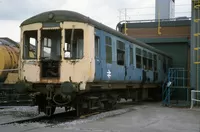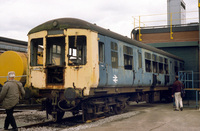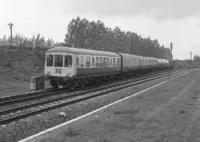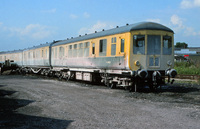Class 100 DMUs in Departmental Use
« ‹ Page 7 of 8, displaying 121-140 of 157 images › »
977191

5th April 1986
977191 seen at Chester on the 5th April 1986. Paul Moxon.

27th March 1987
ADB977191, ex Gloucester class 100, DTC, M56106, keeps a brace of withdrawn class 25's company, in Basford Hall Yard. 27th March 1987. Paul James.

27th March 1987
ADB977191, ex-Gloucester Class 100 DTC M56106, looking a little worse for wear after being shunted through the buffers in Basford Hall Yard, with the rear bogie off the track. 27th March 1987. Paul James.

24th September 1989
ADB977191, 915 M55975 + M55985, M55969+M55968, 914 M55980 + M55984 and 911 M55970 + M55971 at Crewe Basford Hall on 24-9-89. Kevin Dowd.

21st August 1994
977191 at Crewe Basford Hall on the 21st August 1994. S Gaskell.

21st August 1994
977191 (ex-Class 100 56106) taken during the Basford Hall open day, 21/8/94. Robert Frise.

27th January 1995
977191 at Crewe Basford Hall on the 27th January 1995. S Gaskell.

April 1997
Class 100 Test train coach no. 977191, formerly DTCL no. 56106 rots away quietly at Crewe in the company of Class 304 unit no. 013 and some Mk Is, in April 1997. Robert Chilton.

19th February 2000
Two Class 20s drag 100 DTCL 977191, 104 TBSL 59228, 101 DTCL 54350 and three Riviera Trains Mk Is (for brake force) at Crewe on 19/02/00. They were being moved from storage at the South Sidings to the Adtranz Works (drop off the 100) then Gresty Lane. Frank Nicholas.

19th February 2000
977191 during it's departure from Crewe after being out of use for some time. 19/2/2000. Frank Nicholas.

20th February 2000
Class 100 Test train coach 977191 (formerly DTCL no. 56106) is dragged by two Class 20s through Crewe station during a move from the South Carriage sidings where it had spend several years stored to Adtranz Crewe Works where it was intended to be cut up. Saturday 19 February 2000. Frank Nicholas.

20th or 21st May 2000
Last used in the Crewe Works test train, 977191 is seen during the Works open day on 20/21 May 2000. John Horne Collection.

20th May 2000
Class 100 DTC 977191 in Crewe Works during the open day on 20 May 2000. David Mant.

21st May 2000
977191 was formerly 56106, a Gloucester Railway Carriage & Wagon Class 100 driving trailer classified as DTCL, as it had first and second class within, as well as a toilet, It was withdrawn way back in July 1983, but ended up here at Crewe, lingering there until 2002. It is seen at Crewe Works Open Day on the 21st May 2000. Andrew J Crowther.

21st May 2000
Class 100 977191 is seen awaiting disposal at Crewe works during the open day on 21.05.2000. It was converted from 54106 and was used as part of the Crewe test train. Andy Cole.
99900

March 1975
56315 during conversion at St Rollox to 99900. The car was still in it's experimental livery. A replacement front window has been fitted in the front saloon. March 1975. Ken Barnes.

March 1975
56315 at St Rollox for it's conversion to 99900. The car was still in it's experimental livery, but this shows that a blue stripe was also tried as well as the earlier orange stripe, this one having the BR Logo below rather than on the stripe. March 1975. Ken Barnes.

circa mid-1975
The Fisons weedkiller train with converted Class 100 FA99900 (ex-E56315) closest at Haughley Junction on the Great Eastern Main Line. Date unknown, the cleanliness suggests circa mid-1975. A Class 31 is at the far end. Stuart Mackay Collection.

18th May 1978
In the yard of the former Lostock Hall Depot then used for wagon repairs, the Fisons Weedkilling Train was stabled between duties on May 18th 1978. The spray coach, FA99900 was a former Gloucester RC&W DMU car E56315, built in 1958. The other vehicles in the consist were an LMS coach and two GWR full brakes. Martyn Hilbert.

18th May 1978
The Fisons Weedkilling Train had been stabled in the yard of what was once Lostock Hall MPD on the evening of May 18th 1978. The spray coach numbered FA99900, had been converted from a Gloucester Railway Carriage & Wagon Company Class 100 Driving Trailer Composite Lavatory (DTCL) DMU car E56315 that had been built in 1958. Lostock Hall MPD had been the last operational BR steam depot, and following the end of steam in August 1968, the depot serviced and stabled diesels in the Preston area until 1973. The depot then became a railway wagon repair facility until closure in 1990. Martyn Hilbert.


